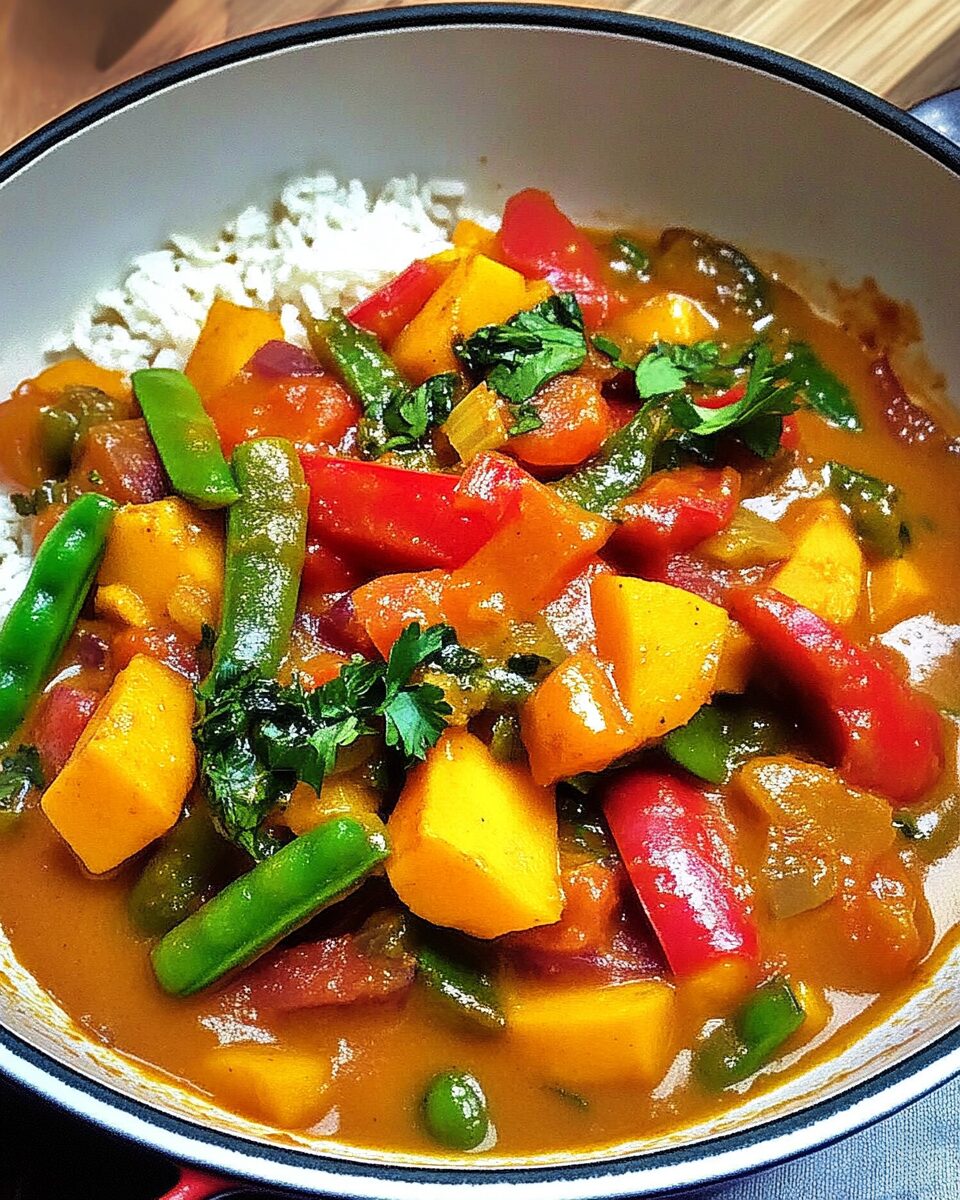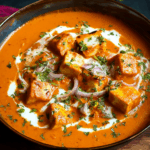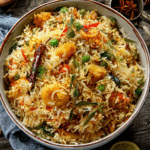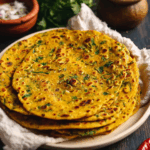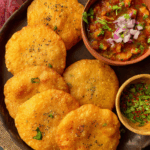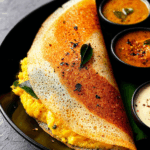This Caribbean Vegetable Curry offers a vibrant and aromatic feast for the senses, combining a colorful array of vegetables with rich, creamy coconut milk and bold island spices. The bright hues of sweet potatoes, red peppers, and green beans make it as visually appealing as it is delicious, while the gentle heat from Scotch bonnet peppers adds a thrilling kick that balances beautifully with the sweetness of the coconut milk.
Perfect for anyone craving a wholesome, comforting meal, this curry is easy to prepare and brings the warm flavors of the Caribbean right into your kitchen. Serve it over fluffy rice or with soft flatbread to soak up every last drop of the sauce, making it an ideal dish for both weeknight dinners and entertaining guests with something exotic yet approachable.
Full recipe:
Ingredients:
-
1 tablespoon vegetable oil
-
1 large onion, chopped
-
2 cloves garlic, minced
-
1 thumb-sized piece of ginger, grated
-
1-2 Scotch bonnet peppers, deseeded and chopped (adjust to taste)
-
2 teaspoons curry powder
-
1 teaspoon ground turmeric
-
1 teaspoon ground cumin
-
1 large sweet potato, peeled and diced
-
2 carrots, sliced
-
1 red pepper, chopped
-
200g green beans, trimmed and halved
-
1 can (400g) chopped tomatoes
-
1 can (400ml) coconut milk
-
Salt to taste
-
Fresh coriander (cilantro) leaves to garnish
-
Cooked rice or flatbread, to serve
Directions:
-
Heat the vegetable oil in a large pan over medium heat. Add the chopped onion and cook gently until soft and translucent, about 5 minutes.
-
Stir in the garlic, grated ginger, and Scotch bonnet peppers. Cook for another 2 minutes, stirring continuously.
-
Add the curry powder, turmeric, and cumin, and cook for 1 minute to release their aromas.
-
Toss in the diced sweet potato, carrots, and red pepper, stirring to coat them well with the spices.
-
Pour in the chopped tomatoes and coconut milk, then season with salt. Bring the mixture to a gentle simmer.
-
Cover the pan and cook for about 20 minutes, or until the vegetables are tender.
-
Add the green beans during the last 5 minutes of cooking so they remain crisp-tender.
-
Adjust seasoning if needed. Serve the curry hot, garnished with fresh coriander, alongside steamed rice or warm flatbread.
Prep Time: 15 minutes | Cooking Time: 30 minutes | Total Time: 45 minutes
Kcal: Approximately 320 kcal per serving | Servings: 4 servings
The Cultural Significance of Caribbean Curry
Curry, as a concept, originated in the Indian subcontinent, but the Caribbean islands have made it their own by incorporating local ingredients and indigenous spices. The arrival of Indian indentured laborers in the Caribbean during the 19th century introduced curry powders and cooking styles, which quickly blended with African, European, and native culinary traditions. Over time, this fusion created the unique and diverse Caribbean curry dishes we enjoy today. The use of Scotch bonnet peppers, coconut milk, and root vegetables like sweet potatoes is typical of Caribbean cuisine, making this vegetable curry a representation of the islands’ rich multicultural history.
Flavor Profile and Spice Balance
One of the highlights of Caribbean Vegetable Curry is its carefully balanced flavor profile. The curry powder provides a warm, earthy base, while turmeric adds vibrant color and subtle bitterness. Ground cumin offers a nutty, aromatic note, which complements the heat from Scotch bonnet peppers—infamous for their fiery kick but used sparingly here to enhance without overwhelming. The addition of fresh ginger and garlic brings sharpness and depth to the dish, making each bite complex and layered. Coconut milk adds creaminess and a natural sweetness that counterbalances the spices, creating a harmonious dish that appeals to a wide range of palates.
Nutritional Benefits and Health Aspects
This vegetable curry is not only flavorful but also highly nutritious. It’s packed with fiber, vitamins, and antioxidants thanks to the variety of vegetables included, such as sweet potatoes, carrots, green beans, and red peppers. Sweet potatoes provide a good source of vitamin A, which supports vision and immune function. Carrots add beta-carotene and dietary fiber, contributing to digestive health. Green beans and red peppers bring vitamin C and other essential minerals. The use of coconut milk, while adding some saturated fats, offers medium-chain triglycerides (MCTs) which are believed to provide quick energy and promote fat metabolism. Overall, this dish fits well into many healthy eating plans, including vegan, gluten-free, and whole-food diets.
Versatility and Customization
One of the best things about Caribbean Vegetable Curry is how adaptable it is. While the recipe calls for specific vegetables, you can easily swap or add seasonal or preferred produce, such as zucchini, eggplant, or even pumpkin. The spice level can also be adjusted depending on your heat tolerance; for a milder curry, reduce or omit the Scotch bonnet peppers or replace them with milder chili varieties. For added protein, consider stirring in chickpeas, tofu, or tempeh. This flexibility makes the dish a reliable go-to for various dietary needs and preferences, perfect for meal prepping or last-minute dinners.
Serving Suggestions and Pairings
Caribbean Vegetable Curry pairs beautifully with simple steamed rice, allowing the bold flavors and creamy sauce to shine. You can also serve it with traditional Caribbean flatbreads such as roti, which are perfect for scooping up the curry. For a more substantial meal, add a side of fried plantains or a fresh mango salsa to introduce contrasting textures and sweetness. A crisp green salad with lime dressing can help balance the richness of the curry. The dish also works well as a vibrant centerpiece for a buffet-style meal, bringing a touch of tropical warmth to any gathering.
Cooking Tips for Perfect Results
To make the most of this curry, gently sweat the onions at the start to develop sweetness, which forms the foundation of the dish’s flavor. Toasting the spices briefly in the pan helps to unlock their full aromatic potential before adding the liquids. Maintaining a gentle simmer ensures the vegetables cook evenly without turning mushy. Adding the green beans near the end keeps their texture intact and adds a fresh crunch. For the best flavor, allow the curry to rest for 10–15 minutes after cooking — this lets the spices meld and deepen.
Why This Recipe is Great for Every Season
Although Caribbean Vegetable Curry evokes tropical sunshine and warm weather, it’s an ideal recipe year-round. The inclusion of root vegetables makes it hearty enough to enjoy during colder months, providing comforting warmth and nourishment. In warmer seasons, its fresh and bright flavors feel light and satisfying. The adaptability of the vegetable components means you can incorporate whatever is fresh and available in your local market, making it a sustainable and seasonal choice that reduces food waste.
Environmental and Ethical Considerations
Choosing a vegetable-based curry like this Caribbean Vegetable Curry also supports environmentally friendly eating habits. Plant-based meals generally have a smaller carbon footprint compared to meat-heavy dishes, contributing to sustainability goals. Using fresh, local, and organic produce where possible not only enhances flavor but supports ethical farming practices. Additionally, this dish’s vegan nature opens the door for ethical food choices that respect animal welfare while still delivering full-bodied flavor and nutrition.
Conclusion
Caribbean Vegetable Curry is more than just a delicious meal—it’s a vibrant expression of Caribbean culture, a nourishing source of plant-based nutrition, and a versatile dish that can be tailored to any taste or occasion. Whether you’re a seasoned cook looking to experiment with global flavors or someone seeking a wholesome, easy-to-prepare dinner, this recipe offers an inviting combination of spice, creaminess, and vegetable goodness. Its balance of heat, sweetness, and aromatic depth ensures it will become a favorite in your kitchen, bringing the warmth and spirit of the Caribbean to your table. By embracing this dish, you’re not just enjoying a tasty meal—you’re celebrating a rich culinary tradition and making a positive impact through mindful, healthy eating.

